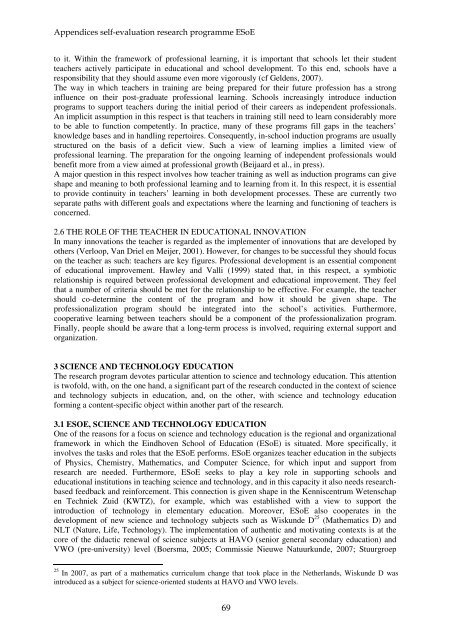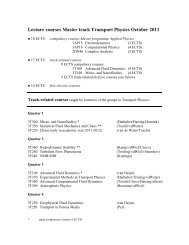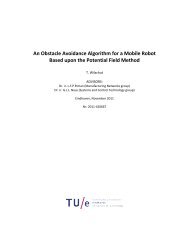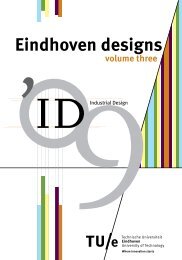Self-evaluation - Technische Universiteit Eindhoven
Self-evaluation - Technische Universiteit Eindhoven
Self-evaluation - Technische Universiteit Eindhoven
Create successful ePaper yourself
Turn your PDF publications into a flip-book with our unique Google optimized e-Paper software.
Appendices self-<strong>evaluation</strong> research programme ESoE<br />
to it. Within the framework of professional learning, it is important that schools let their student<br />
teachers actively participate in educational and school development. To this end, schools have a<br />
responsibility that they should assume even more vigorously (cf Geldens, 2007).<br />
The way in which teachers in training are being prepared for their future profession has a strong<br />
influence on their post-graduate professional learning. Schools increasingly introduce induction<br />
programs to support teachers during the initial period of their careers as independent professionals.<br />
An implicit assumption in this respect is that teachers in training still need to learn considerably more<br />
to be able to function competently. In practice, many of these programs fill gaps in the teachers’<br />
knowledge bases and in handling repertoires. Consequently, in-school induction programs are usually<br />
structured on the basis of a deficit view. Such a view of learning implies a limited view of<br />
professional learning. The preparation for the ongoing learning of independent professionals would<br />
benefit more from a view aimed at professional growth (Beijaard et al., in press).<br />
A major question in this respect involves how teacher training as well as induction programs can give<br />
shape and meaning to both professional learning and to learning from it. In this respect, it is essential<br />
to provide continuity in teachers’ learning in both development processes. These are currently two<br />
separate paths with different goals and expectations where the learning and functioning of teachers is<br />
concerned.<br />
2.6 THE ROLE OF THE TEACHER IN EDUCATIONAL INNOVATION<br />
In many innovations the teacher is regarded as the implementer of innovations that are developed by<br />
others (Verloop, Van Driel en Meijer, 2001). However, for changes to be successful they should focus<br />
on the teacher as such: teachers are key figures. Professional development is an essential component<br />
of educational improvement. Hawley and Valli (1999) stated that, in this respect, a symbiotic<br />
relationship is required between professional development and educational improvement. They feel<br />
that a number of criteria should be met for the relationship to be effective. For example, the teacher<br />
should co-determine the content of the program and how it should be given shape. The<br />
professionalization program should be integrated into the school’s activities. Furthermore,<br />
cooperative learning between teachers should be a component of the professionalization program.<br />
Finally, people should be aware that a long-term process is involved, requiring external support and<br />
organization.<br />
3 SCIENCE AND TECHNOLOGY EDUCATION<br />
The research program devotes particular attention to science and technology education. This attention<br />
is twofold, with, on the one hand, a significant part of the research conducted in the context of science<br />
and technology subjects in education, and, on the other, with science and technology education<br />
forming a content-specific object within another part of the research.<br />
3.1 ESOE, SCIENCE AND TECHNOLOGY EDUCATION<br />
One of the reasons for a focus on science and technology education is the regional and organizational<br />
framework in which the <strong>Eindhoven</strong> School of Education (ESoE) is situated. More specifically, it<br />
involves the tasks and roles that the ESoE performs. ESoE organizes teacher education in the subjects<br />
of Physics, Chemistry, Mathematics, and Computer Science, for which input and support from<br />
research are needed. Furthermore, ESoE seeks to play a key role in supporting schools and<br />
educational institutions in teaching science and technology, and in this capacity it also needs researchbased<br />
feedback and reinforcement. This connection is given shape in the Kenniscentrum Wetenschap<br />
en Techniek Zuid (KWTZ), for example, which was established with a view to support the<br />
introduction of technology in elementary education. Moreover, ESoE also cooperates in the<br />
development of new science and technology subjects such as Wiskunde D 25 (Mathematics D) and<br />
NLT (Nature, Life, Technology). The implementation of authentic and motivating contexts is at the<br />
core of the didactic renewal of science subjects at HAVO (senior general secondary education) and<br />
VWO (pre-university) level (Boersma, 2005; Commissie Nieuwe Natuurkunde, 2007; Stuurgroep<br />
25 In 2007, as part of a mathematics curriculum change that took place in the Netherlands, Wiskunde D was<br />
introduced as a subject for science-oriented students at HAVO and VWO levels.<br />
69

















